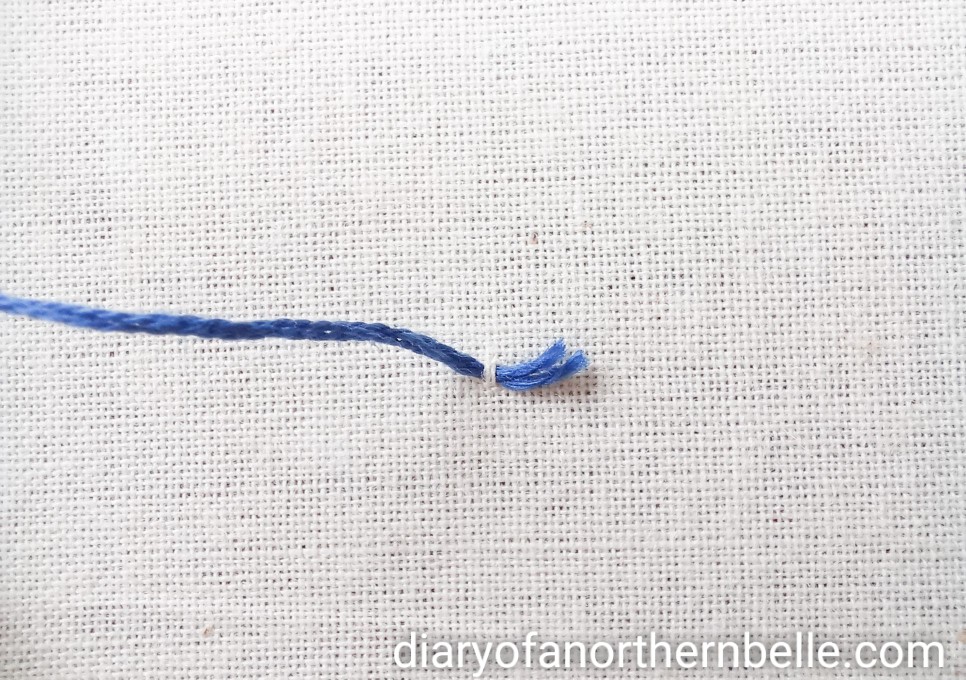Who’s ready for a hand embroidery pattern freebie? 🙂

Read on to download this sweet wisteria embroidery pattern & see the tutorial. 🙂 Last week, I introduced you to one of my new favourite novels, The Enchanted April, by Elizabeth von Arnim. We talked about how dreamy and escapist it was, and how much flower inspiration there was to be found in it. The wisteria in particular, proved to be a wonderful subject for embroidery!
If you haven’t seen that post, check it out here.
I showed you a bit of how I embroidered my wisteria-inspired project, and if you liked it then the good news is that I have more wisteria for you this week!


I created this pattern so I could share my newfound love of wisteria with you all. Now you can stitch your own! May it bring you sunshine and happiness as promised in The Enchanted April.
The pattern is super simple and accessible to beginners. I only used three basic stitches: the split stitch, the lazy-daisy stitch, and a form of leaf stitch. Simply click on any of these for a full tutorial on how to work them.
See also: The Only Embroidery Tools You Really Need to know which basic materials you will need for this project.
Tutorial:
I used DMC floss, but you can use another brand if you like. You can find a good conversion chart here. I used 2 strands throughout the whole project.
#153 (Vy Lt. Violet)
#210 (Md. Lavender)
#470 (Lt. Avocado Green)
#553 (Violet)
#3011 (Dk. Khaki Green)
#3042 (Lt. Antique Violet)
See also this post on How to Start & End Your Stitches.
1. Branches
Begin by stitching the branches (or stems?) with #470 . Since the leaves and the flowers will go over it, it’s easier to start with it first. I used the split stitch, but feel free to use any other outline stitch that you like, such as the backstitch or the stem stitch. Stitch all the way down the middle of the flower cluster. Some of it will show through once the flowers are stitched. You can also stop the branch before the cluster if you don’t want it showing through or you want to make your flowers very tight together.

2. Leaves
There are many ways to embroider leaves, but I kept it super simple here and just stitched mine with a simple leaf stitch. The method I use is kind of a cross between satin stitch and fishbone stitch. Using 2 strands of #470, make a small straight stitch from the top of the leaf to the top of the guideline running down the middle vein.

Work your way down the leaf by starting your stitches on the outline of the leaf and ending on the middle guideline for the central vein. Make your stitches at a diagonal angle to keep the shape of the leaf. I like to work one side at a time (usually I start with the right).

If you’re satisfied with the look of the leaves as they are after this step, you can skip the next step! I just wanted to add a bit more colour and texture to mine.
Using #3011, make a straight stitch down the middle of the leaf for the main vein. I also added two very small stitches on either side, also on a slight angle.

3. The Flowers
The flowers are all worked in lazy-daisy stitches, sort of scattered in a downward motion and fairly close together to create the droopy cluster effect. On your pattern, the dotted line indicates the shape the finished cluster will take. You don’t have to transfer that line on your fabric as it may leave marks if it’s not entirely covered in stitches. It’s more just to give you an idea of the finished size and shape. You can transfer the straight lines going down from the stem, as those should be all covered and will help you to guide the placement of your stitches.
You want to work your lazy-daisies downward, some going straight down, and others going at slight angles from the branch. There is no specific placement for each of them though, and this is a very forgiving flower for embroidery. One stitch or two out of place will only add shape to it! Have fun with it and experiment with where you place your stitches if you want to change the shape a bit, or the way it hangs.


I used #153, #3042 and #210 for the smaller branch, and #153, #3042 and #553 for the bigger one.

And there you go! I decided to add a little bow at the last minute to give it a more finished look. I used a piece of narrow white satin ribbon, tied it into a bow and sewed it to the base of the branch.

It looks pretty cute I think! I really hope you have fun stitching this wisteria pattern. This is the first “real” pattern I’ve ever made so I’m pretty excited. Any feedback will be super appreciated and I would love it if you show me your results! Tag me on Instagram @northernbelle.atelier if you try this wisteria pattern! 🙂 Also don’t hesitate to reach out for any questions or comments and be sure to subscribe to my newsletter for more embroidery content!
Fondly,

















































































































